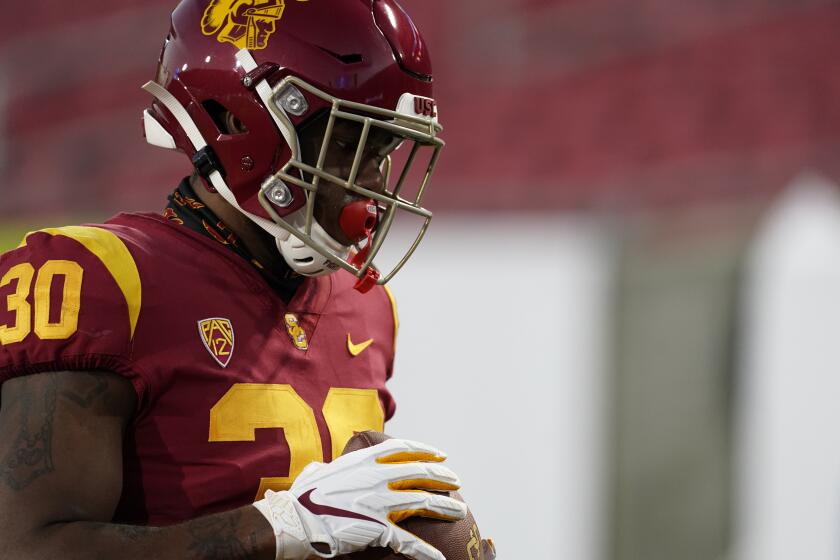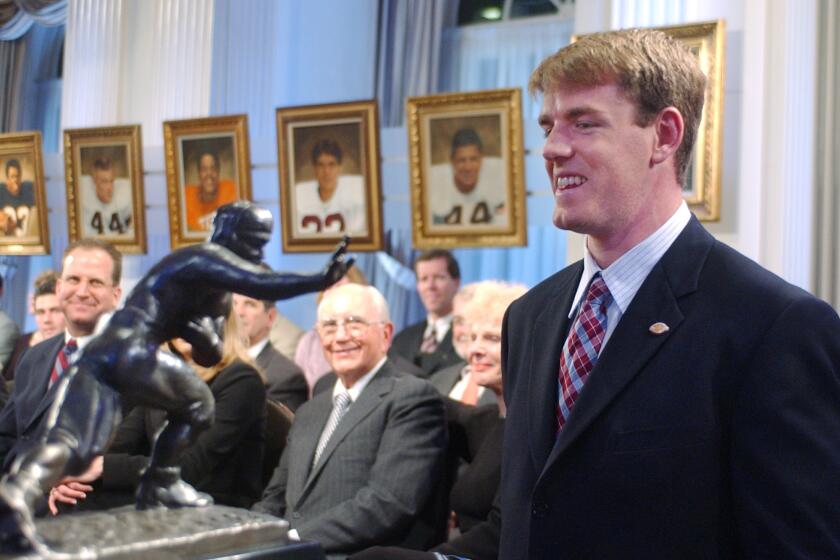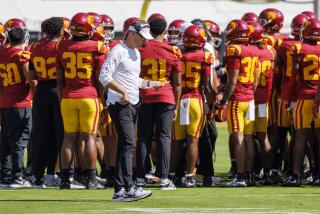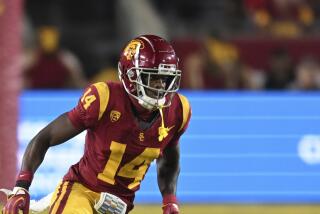There’s no excuses for USC’s poor running game, Mike Jinks says
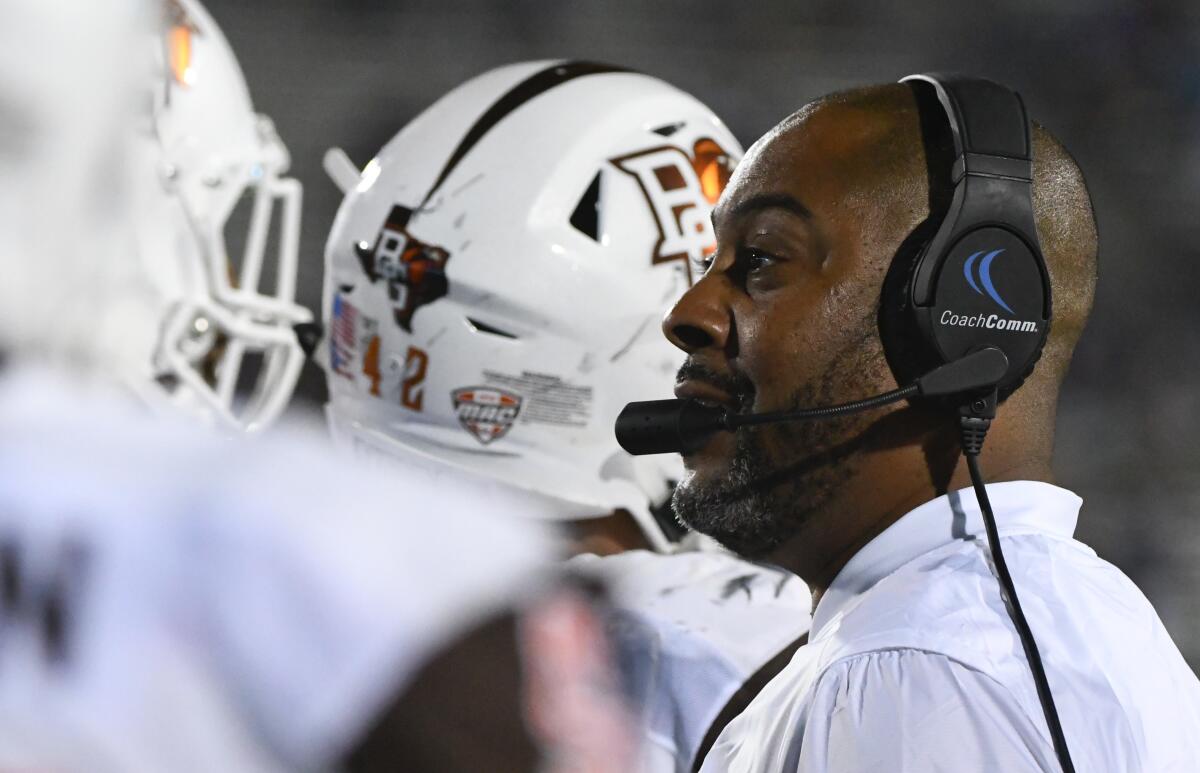
Mike Jinks is ready for brutal honesty.
After the worst season USC has had on the ground in two decades, an especially brutal assessment of its run game — and running backs coach — is warranted. The Trojans finished last in the Pac-12 and 120th in the nation in yards rushing per game (97), and Jinks, the man presiding over that backfield, understands there’s no reason for such a staggering slide.
“We’re not in the business of making excuses,” Jinks said in a phone interview Thursday. “At the end of the day, we didn’t run it as well as we would’ve liked. That’s something that needs to be addressed.”
One assistant was already fired in an attempt to confront those issues. USC parted ways with offensive line coach and run game coordinator Tim Drevno this month, in large part because of its flailing run game and his imperfect fit in the Air Raid offense.
While Drevno was ousted, Jinks was retained. That security didn’t always seem so assured at the start of January, Jinks admits. But now, ahead of his third season at USC, the responsibility of remaking the Trojans’ run game will again fall to him.
He’s already got some ideas on where to start.
Two weeks after entering the NCAA transfer portal, former USC running back Markese Stepp announced he’s committed to the Nebraska Cornhuskers.
The first order of business is to find a lead back. Over his two seasons, Jinks kept a fairly even rotation among USC’s top running backs, with no back exceeding 38% of the team’s carries. In his third, Jinks said, he’s planning to be more top heavy.
“I want an RB1 and an RB2,” he said. “Those guys are going to get the majority of our touches. They’re going to be allowed to get into a rhythm. The other guys, they’re going to have to contribute on special teams and wait for their opportunity.”
Injuries derailed any hope for that approach in 2019, with USC so banged-up at running back it was forced to use receivers in the backfield. The pandemic made matters even more difficult in 2020, with no spring practice to establish who deserved the most carries.
“Nobody was able to establish and take that job,” Jinks said. “When [Vavae Malepeai] got those 19-20 some touches against UCLA, we’re a completely different football team when that happens. That’s ultimately what I want to happen. I don’t care which one of the guys it is. But we’ve got to have a guy.”
Malepeai was largely that guy by default in each of the last two seasons, leading USC in rushing, while Stephen Carr was close behind. Either could step into that primary role in 2021, as both seniors have told Jinks that they plan to return for a fifth season, using the additional year of eligibility afforded to them by the NCAA because of the pandemic.
Neither will have to contend with the back many believed would become the Trojans’ workhorse. After three injury-riddled seasons at USC, Markese Stepp announced his transfer to Nebraska this week.
The decision followed a season in which his role diminished amid a series of nagging ailments that limited him to six carries over a three-game stretch between November and December. Stepp did return to lead the backfield during the Pac-12 title game, tallying 13 carries for 25 yards in place of Malepeai, who sat out with an injury.
Jinks said he had “some real conversations” with Stepp about where he stood in USC’s plans, and Stepp “made the decision that was best for him.”
“Everybody wants to be RB1, and I can respect that from him,” Jinks said. “It was nothing that he’s done wrong. He got hurt, and through that, Vae had proven he’s our RB1.”
USC should at least have better luck finding a rhythm in the run game with less of a rotation. What that approach will mean for the running backs toiling behind the top two remains to be seen.
Speedy back Kenan Christon burst onto the scene as a freshman but was largely forgotten as a sophomore, with only 10 carries over six games. Jinks attributed that change largely to the weight Christon lost over the course of the pandemic. After reaching nearly 190 pounds before the season was postponed, Christon was down to 172 pounds by the delayed start of the season.
“We have to figure out what his body is going to do,” Jinks said. “If he can put on that weight, he has the skillset to be a more than effective running back in this system.”
Former USC quarterback and Heisman winner Carson Palmer is among 13 players and coaches who make up the latest College Football Hall of Fame class.
USC is even less sure of what to expect from freshman Brandon Campbell, who will enroll early this spring. If he’s able to pick up the offense quickly, he could be in the mix, Jinks said.
For now, there are far more questions than answers for a backfield fresh off of one of the worst rushing seasons in college football. USC hadn’t rushed for fewer yards per game since it averaged 87 in 2001, Pete Carroll’s first season with the Trojans.
The coach behind the backfield knows that a better ground game is imperative, if USC has any hope of taking a step forward in 2021.
“The bottom line is do we want to go to the Pac-12 championship? Or do we want to win the Pac-12 and go to the national championship?” Jinks said. “You’re not able to do that unless you can run the football. Period. That’s the bottom line.”
More to Read
Go beyond the scoreboard
Get the latest on L.A.'s teams in the daily Sports Report newsletter.
You may occasionally receive promotional content from the Los Angeles Times.

